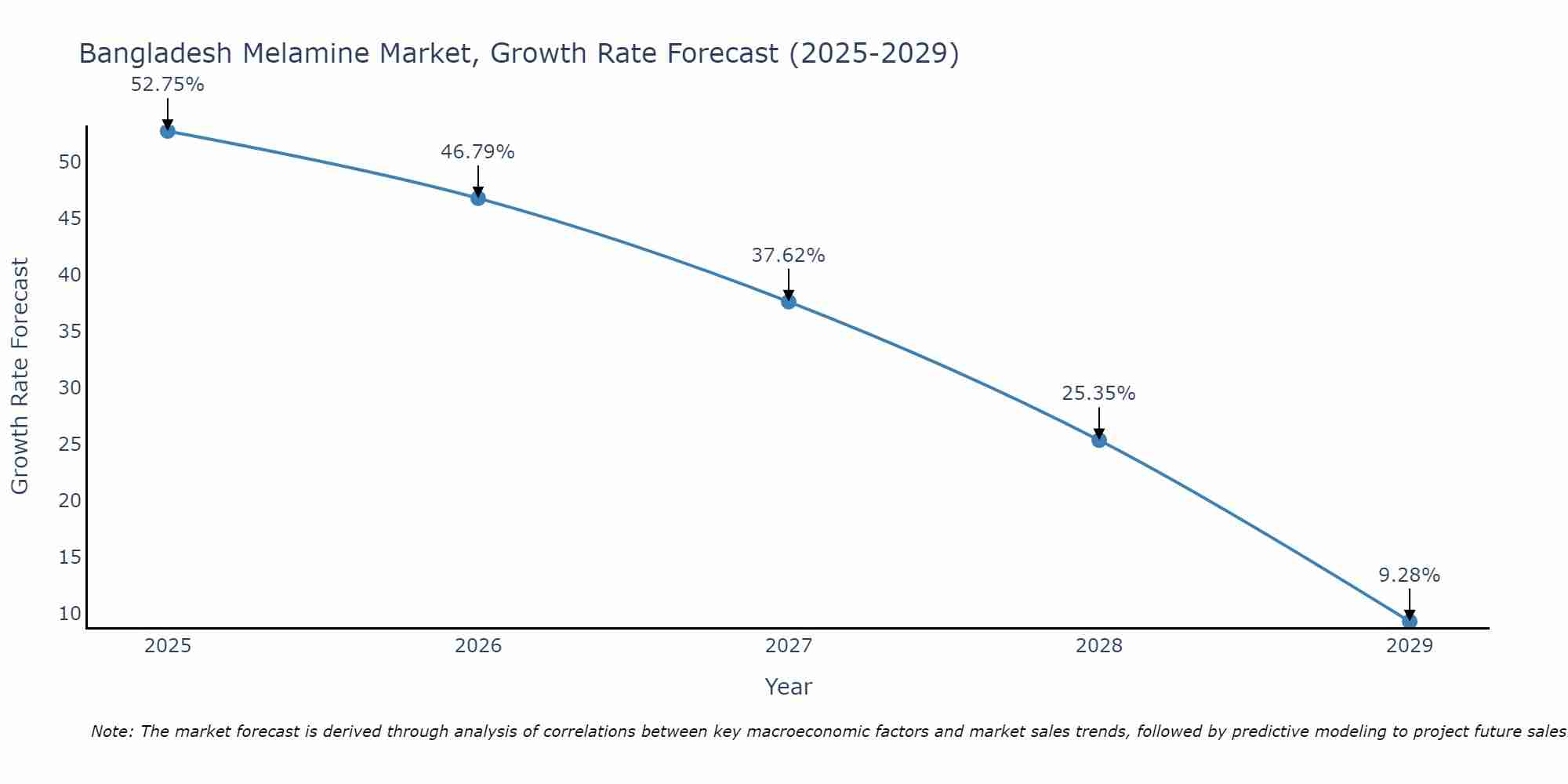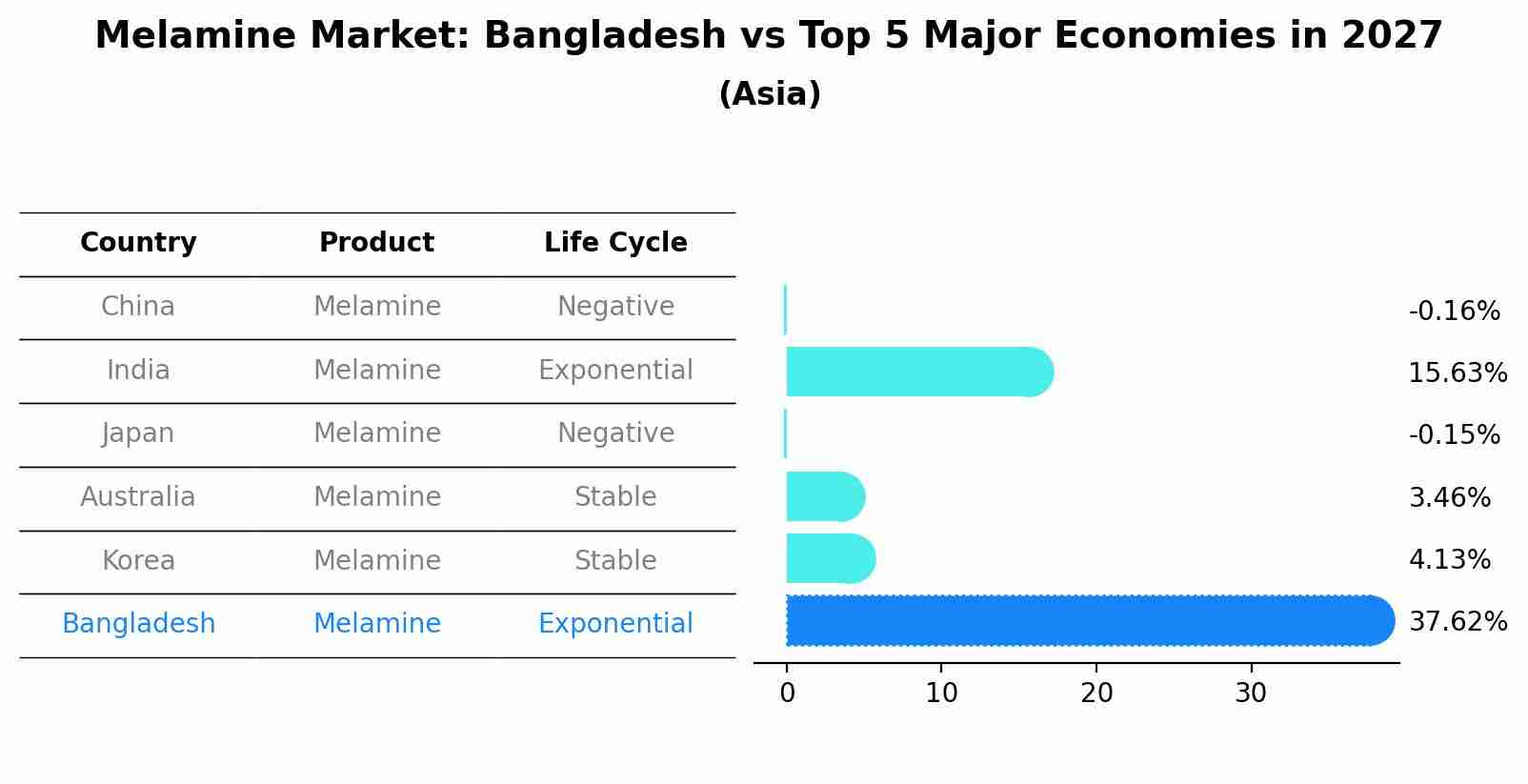Bangladesh Melamine Market (2025-2031) Outlook | Value, Growth, Revenue, Companies, Trends, Share, Analysis, Forecast, Size & Industry
| Product Code: ETC092031 | Publication Date: Jun 2021 | Updated Date: Jun 2025 | Product Type: Report | |
| Publisher: 6Wresearch | Author: Sachin Kumar Rai | No. of Pages: 70 | No. of Figures: 35 | No. of Tables: 5 |
Bangladesh Melamine Market Size Growth Rate
The Bangladesh Melamine Market may undergo a gradual slowdown in growth rates between 2025 and 2029. Although the growth rate starts strong at 52.75% in 2025, it steadily loses momentum, ending at 9.28% by 2029.

Melamine Market: Bangladesh vs Top 5 Major Economies in 2027 (Asia)
Bangladesh's Melamine market is anticipated to experience a exponential growth rate of 37.62% by 2027, reflecting trends observed in the largest economy China, followed by India, Japan, Australia and South Korea.

Bangladesh Melamine Market Overview
The Bangladesh Melamine market is experiencing steady growth driven by the increasing demand from the country`s booming construction, automotive, and consumer goods industries. Melamine, a synthetic resin used in the production of laminates, tableware, and coatings, is witnessing a rise in consumption as a result of expanding urbanization and infrastructure development projects in Bangladesh. The market is characterized by a competitive landscape with key players such as SQ Group, Akij Group, and Bengal Melamine Industries dominating the industry. Additionally, the growing awareness about the benefits of melamine products in terms of durability, hygiene, and aesthetics is further fueling market growth. However, challenges such as fluctuating raw material prices and environmental concerns regarding melamine production processes remain key factors influencing the market dynamics in Bangladesh.
Bangladesh Melamine Market Trends
The Bangladesh Melamine market is experiencing growth due to the increasing demand from the construction and furniture industries. With the rise in urbanization and disposable income, there is a higher preference for modern and aesthetically pleasing interior designs, driving the demand for melamine-based products such as laminates and decorative panels. Additionally, the growing awareness about the durability and cost-effectiveness of melamine compared to traditional materials like wood has further fueled its market growth. Manufacturers are also focusing on introducing innovative designs and patterns to cater to the evolving consumer preferences. However, challenges such as fluctuating raw material prices and competition from alternative materials continue to impact the market dynamics, prompting players to strategize and adapt to sustain their market position.
Bangladesh Melamine Market Challenges
In the Bangladesh Melamine Market, some of the key challenges include intense competition among local and international manufacturers, fluctuating prices of raw materials such as urea and formaldehyde, and the presence of counterfeit products that undermine consumer trust in the quality of melamine products. Additionally, issues related to product quality control, lack of standardized regulations, and limited awareness among consumers about the benefits and uses of melamine further contribute to the challenges faced in the market. To succeed in this competitive landscape, companies operating in the Bangladesh Melamine Market need to focus on maintaining consistent product quality, building strong distribution networks, and investing in marketing efforts to educate consumers about the advantages of using melamine products.
Bangladesh Melamine Market Investment Opportunities
The Bangladesh Melamine market presents attractive investment opportunities due to the country`s growing construction and infrastructure sectors. With increasing urbanization and a rising middle-class population, the demand for melamine, a key ingredient in the production of laminates and decorative surfaces, is on the rise. Investors can consider opportunities in establishing melamine manufacturing facilities or partnering with existing manufacturers to expand production capacity. Additionally, investing in distribution networks and marketing strategies can help capture a larger market share in Bangladesh`s thriving construction industry. As the economy continues to grow and consumer preferences trend towards modern interior design solutions, investments in the Bangladesh Melamine market have the potential for long-term returns.
Bangladesh Melamine Market Government Policy
The government of Bangladesh has implemented strict regulations and quality control measures in response to the melamine market. The Bangladesh Standards and Testing Institution (BSTI) has set maximum allowable limits for melamine in food products, with regular monitoring and testing conducted to ensure compliance. Additionally, the government has taken steps to crack down on the illegal import and production of melamine, with severe penalties imposed on violators. These policies aim to protect public health and consumer interests by ensuring that melamine levels in food products remain within safe limits, thereby safeguarding the reputation of Bangladesh`s food industry and promoting consumer trust in the market.
Bangladesh Melamine Market Future Outlook
The Bangladesh melamine market is expected to witness steady growth in the coming years due to increasing demand in various end-use industries such as construction, automotive, and packaging. Factors driving this growth include rising disposable income, urbanization, and a growing population. Additionally, the government`s focus on infrastructure development and initiatives to attract foreign investments are likely to further boost the market. However, challenges such as fluctuating raw material prices and environmental concerns regarding melamine production could hinder market growth. Overall, with increasing industrialization and demand for high-quality products, the Bangladesh melamine market is expected to expand at a moderate pace in the foreseeable future.
Key Highlights of the Report:
- Bangladesh Melamine Market Outlook
- Market Size of Bangladesh Melamine Market, 2021
- Forecast of Bangladesh Melamine Market, 2031
- Historical Data and Forecast of Bangladesh Melamine Revenues & Volume for the Period 2021 - 2031
- Bangladesh Melamine Market Trend Evolution
- Bangladesh Melamine Market Drivers and Challenges
- Bangladesh Melamine Price Trends
- Bangladesh Melamine Porter's Five Forces
- Bangladesh Melamine Industry Life Cycle
- Historical Data and Forecast of Bangladesh Melamine Market Revenues & Volume By Forms for the Period 2021 - 2031
- Historical Data and Forecast of Bangladesh Melamine Market Revenues & Volume By Melamine Resin for the Period 2021 - 2031
- Historical Data and Forecast of Bangladesh Melamine Market Revenues & Volume By Melamine Foams for the Period 2021 - 2031
- Historical Data and Forecast of Bangladesh Melamine Market Revenues & Volume By Applications for the Period 2021 - 2031
- Historical Data and Forecast of Bangladesh Melamine Market Revenues & Volume By Laminates for the Period 2021 - 2031
- Historical Data and Forecast of Bangladesh Melamine Market Revenues & Volume By Wood Adhesives for the Period 2021 - 2031
- Historical Data and Forecast of Bangladesh Melamine Market Revenues & Volume By Surface Coatings for the Period 2021 - 2031
- Historical Data and Forecast of Bangladesh Melamine Market Revenues & Volume By Thermoset Plastics for the Period 2021 - 2031
- Historical Data and Forecast of Bangladesh Melamine Market Revenues & Volume By End-users for the Period 2021 - 2031
- Historical Data and Forecast of Bangladesh Melamine Market Revenues & Volume By Construction for the Period 2021 - 2031
- Historical Data and Forecast of Bangladesh Melamine Market Revenues & Volume By Chemical for the Period 2021 - 2031
- Historical Data and Forecast of Bangladesh Melamine Market Revenues & Volume By Textile for the Period 2021 - 2031
- Historical Data and Forecast of Bangladesh Melamine Market Revenues & Volume By Automotive for the Period 2021 - 2031
- Bangladesh Melamine Import Export Trade Statistics
- Market Opportunity Assessment By Forms
- Market Opportunity Assessment By Applications
- Market Opportunity Assessment By End-users
- Bangladesh Melamine Top Companies Market Share
- Bangladesh Melamine Competitive Benchmarking By Technical and Operational Parameters
- Bangladesh Melamine Company Profiles
- Bangladesh Melamine Key Strategic Recommendations
Frequently Asked Questions About the Market Study (FAQs):
- Single User License$ 1,995
- Department License$ 2,400
- Site License$ 3,120
- Global License$ 3,795
Search
Thought Leadership and Analyst Meet
Our Clients
Related Reports
- Afghanistan Apparel Market (2026-2032) | Growth, Outlook, Industry, Segmentation, Forecast, Size, Companies, Trends, Value, Share, Analysis & Revenue
- Canada Oil and Gas Market (2026-2032) | Share, Segmentation, Value, Industry, Trends, Forecast, Analysis, Size & Revenue, Growth, Competitive Landscape, Outlook, Companies
- Germany Breakfast Food Market (2026-2032) | Industry, Share, Growth, Size, Companies, Value, Analysis, Revenue, Trends, Forecast & Outlook
- Australia Briquette Market (2025-2031) | Growth, Size, Revenue, Forecast, Analysis, Trends, Value, Share, Industry & Companies
- Vietnam System Integrator Market (2025-2031) | Size, Companies, Analysis, Industry, Value, Forecast, Growth, Trends, Revenue & Share
- ASEAN and Thailand Brain Health Supplements Market (2025-2031) | Strategy, Consumer Insights, Analysis, Investment Trends, Opportunities, Growth, Size, Share, Industry, Revenue, Segments, Value, Segmentation, Supply, Forecast, Restraints, Outlook, Competition, Drivers, Trends, Demand, Pricing Analysis, Competitive, Strategic Insights, Companies, Challenges
- ASEAN Bearings Market (2025-2031) | Strategy, Consumer Insights, Analysis, Investment Trends, Opportunities, Growth, Size, Share, Industry, Revenue, Segments, Value, Segmentation, Supply, Forecast, Restraints, Outlook, Competition, Drivers, Trends, Demand, Pricing Analysis, Competitive, Strategic Insights, Companies, Challenges
- Europe Flooring Market (2025-2031) | Outlook, Share, Industry, Trends, Forecast, Companies, Revenue, Size, Analysis, Growth & Value
- Saudi Arabia Manlift Market (2025-2031) | Outlook, Size, Growth, Trends, Companies, Industry, Revenue, Value, Share, Forecast & Analysis
- Uganda Excavator, Crane, and Wheel Loaders Market (2025-2031) | Strategy, Consumer Insights, Analysis, Investment Trends, Opportunities, Growth, Size, Share, Industry, Revenue, Segments, Value, Segmentation, Supply, Forecast, Restraints, Outlook, Competition, Drivers, Trends, Demand, Pricing Analysis, Competitive, Strategic Insights, Companies, Challenges
Industry Events and Analyst Meet
Whitepaper
- Middle East & Africa Commercial Security Market Click here to view more.
- Middle East & Africa Fire Safety Systems & Equipment Market Click here to view more.
- GCC Drone Market Click here to view more.
- Middle East Lighting Fixture Market Click here to view more.
- GCC Physical & Perimeter Security Market Click here to view more.
6WResearch In News
- Doha a strategic location for EV manufacturing hub: IPA Qatar
- Demand for luxury TVs surging in the GCC, says Samsung
- Empowering Growth: The Thriving Journey of Bangladesh’s Cable Industry
- Demand for luxury TVs surging in the GCC, says Samsung
- Video call with a traditional healer? Once unthinkable, it’s now common in South Africa
- Intelligent Buildings To Smooth GCC’s Path To Net Zero


















